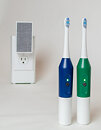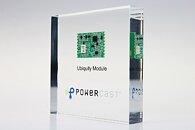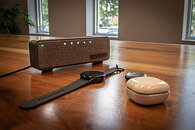TheLostSwede
News Editor
- Joined
- Nov 11, 2004
- Messages
- 17,574 (2.40/day)
- Location
- Sweden
| System Name | Overlord Mk MLI |
|---|---|
| Processor | AMD Ryzen 7 7800X3D |
| Motherboard | Gigabyte X670E Aorus Master |
| Cooling | Noctua NH-D15 SE with offsets |
| Memory | 32GB Team T-Create Expert DDR5 6000 MHz @ CL30-34-34-68 |
| Video Card(s) | Gainward GeForce RTX 4080 Phantom GS |
| Storage | 1TB Solidigm P44 Pro, 2 TB Corsair MP600 Pro, 2TB Kingston KC3000 |
| Display(s) | Acer XV272K LVbmiipruzx 4K@160Hz |
| Case | Fractal Design Torrent Compact |
| Audio Device(s) | Corsair Virtuoso SE |
| Power Supply | be quiet! Pure Power 12 M 850 W |
| Mouse | Logitech G502 Lightspeed |
| Keyboard | Corsair K70 Max |
| Software | Windows 10 Pro |
| Benchmark Scores | https://valid.x86.fr/yfsd9w |
Powercast Corporation, the leader in radio-frequency (RF)-based over-the-air wireless power technology, has unveiled its Ubiquity transmitter, an ultra-low-cost RF power transmitter which was selected as a CES 2023 Innovation Award Honoree in three categories: Smart Home, Embedded Technologies and Sustainability, Eco-Design & Smart Energy.
Designed to be the industry's most economical RF wireless transmitter, Powercast has lowered the barrier to entry where RF wireless power can actually become ubiquitous with multiple RF transmitters covering every home. Ubiquity will be on display in Powercast's booth #52311 at the Venetian Expo in the Smart Home Marketplace during CES 2023 in Las Vegas, January 5 - 8, 2023.



"Powercast's vision is to see a low-cost RF transmitter in every room in every house," said Charles Goetz, CEO at Powercast. "Much like Wi-Fi routers, a home will need multiple RF transmitters to provide enough RF coverage where convenient, contactless, 'set it and forget it' wireless charging becomes a reality. So, we slashed costs and are sharing our Ubiquity design via a reference design with a low $5 bill of material cost, or an embeddable module, that lets manufacturers easily incorporate RF transmitting capability into their own products to accelerate RF transmitter networks in homes."
Powercast's over-the-air wireless power architecture has two sides: 1) a transmitter sends RF over the air, and 2) a receiver embedded in end devices harvests that RF from the air and converts it into DC (direct current) to both communicate data, and power devices.
On the transmitter side, Powercast's Ubiquity will come in several forms, all able to both charge RF-enabled devices and communicate data back and forth with them throughout a home:
On the receiving side, manufacturers can embed Powercast's tiny Powerharvester PCC110 receiver chip and a small antenna into their end devices for around $1 to enable them to work with an RF transmitter - either Powercast's standalone Ubiquity, or RF-transmitting products created using the Ubiquity embeddable module or reference design.
This wireless power-over-distance architecture is perfect for charging low-power devices with continuous, reliable, background trickle charging. End device examples include TV remotes, electric toothbrushes, keyboards and mice, game controllers, earbuds, headphones, smart watches, fitness bands, hearing aids, clocks, electric shavers, home automation devices and many more devices.
Powercast's Director of Research and Development Jason Gill explained, "The volumes are in the consumer electronics market, but it's also price sensitive. In response to these manufacturers' requests for a sustainable, ultra-low-cost wireless charging solution, our engineers perfected the highly-efficient, single-antenna Ubiquity design that can both transmit power and communicate data. Manufacturers can create environmentally-friendly, RF-powered ecosystems using either rechargeable batteries or no batteries, both of which eliminate disposable battery e-waste and battery replacement hassles."
The Ubiquity transmitter can output up to 1 W (3 W EIRP) and automatically charges multiple RF-enabled devices that come into its charging zone - no charging mats needed. Power-hungry devices charge faster within several feet of the transmitter, while ultra-low-power devices like IoT sensors can charge up to 120 feet.
"The far-field wireless power transmitter semiconductor market will soon see a steep growth trajectory with most revenue coming from the consumer market," said Phil Solis, research director at IDC. "On the receiver side, the consumer market will be the largest segment by 2024 and the vast majority of revenue by 2025. Low-cost solutions are necessary to enable the many devices in the home that can benefit from wireless power."
The licensable Ubiquity reference design is expected in February 2023. The Ubiquity module and transmitter are expected in June 2023.
Powercast's Booth #52311 Demonstrates the Home of the Future with RF Wireless Power Everywhere:
Representing the living room and bathroom of the future, Powercast will demo a distributed network of Ubiquity RF transmitters that keep RF-enabled devices working throughout the home. Devices include electric toothbrushes, TV remotes, game controllers, automatic faucets, smart home sensors (water leak, plant moister, thermostats), wall clocks and more.
"RF technology enables a fundamental change in the way our bathroom works," said Charles Greene, Ph.D., COO and CTO of Powercast. "One transmitter charges all low-power devices like toothbrushes and shavers. RF-powered products eliminate cords around water and hence the chance for electric shock. RF also eliminates the inconveniences of the electric toothbrush - no more dock to accumulate grime, and no more need for batteries that often corrode from water seeping in."
View at TechPowerUp Main Site | Source
Designed to be the industry's most economical RF wireless transmitter, Powercast has lowered the barrier to entry where RF wireless power can actually become ubiquitous with multiple RF transmitters covering every home. Ubiquity will be on display in Powercast's booth #52311 at the Venetian Expo in the Smart Home Marketplace during CES 2023 in Las Vegas, January 5 - 8, 2023.



"Powercast's vision is to see a low-cost RF transmitter in every room in every house," said Charles Goetz, CEO at Powercast. "Much like Wi-Fi routers, a home will need multiple RF transmitters to provide enough RF coverage where convenient, contactless, 'set it and forget it' wireless charging becomes a reality. So, we slashed costs and are sharing our Ubiquity design via a reference design with a low $5 bill of material cost, or an embeddable module, that lets manufacturers easily incorporate RF transmitting capability into their own products to accelerate RF transmitter networks in homes."
Powercast's over-the-air wireless power architecture has two sides: 1) a transmitter sends RF over the air, and 2) a receiver embedded in end devices harvests that RF from the air and converts it into DC (direct current) to both communicate data, and power devices.
On the transmitter side, Powercast's Ubiquity will come in several forms, all able to both charge RF-enabled devices and communicate data back and forth with them throughout a home:
- Manufacturers have two options to turn their own products - such as home appliances, TVs, game systems, computer monitors or AI-enabled home assistants - into Ubiquity RF transmitters:
- A licensable reference design provides flexibility and ultimate cost savings for manufacturers to integrate just the electronics needed onto their own circuit boards for $5 or less bill-of-material (BOM) cost.
- An easy-to-integrate, drop-in embeddable module contains all the electronics and hardware needed. Manufacturers will add a power supply and antenna. Powercast will work with manufacturers on an antenna design that best fits their specific product size.
- Powercast also created a standalone Ubiquity transmitter combining its embeddable module with an antenna to show at CES. Powercast will produce this portable-speaker-sized transmitter.
On the receiving side, manufacturers can embed Powercast's tiny Powerharvester PCC110 receiver chip and a small antenna into their end devices for around $1 to enable them to work with an RF transmitter - either Powercast's standalone Ubiquity, or RF-transmitting products created using the Ubiquity embeddable module or reference design.
This wireless power-over-distance architecture is perfect for charging low-power devices with continuous, reliable, background trickle charging. End device examples include TV remotes, electric toothbrushes, keyboards and mice, game controllers, earbuds, headphones, smart watches, fitness bands, hearing aids, clocks, electric shavers, home automation devices and many more devices.
Powercast's Director of Research and Development Jason Gill explained, "The volumes are in the consumer electronics market, but it's also price sensitive. In response to these manufacturers' requests for a sustainable, ultra-low-cost wireless charging solution, our engineers perfected the highly-efficient, single-antenna Ubiquity design that can both transmit power and communicate data. Manufacturers can create environmentally-friendly, RF-powered ecosystems using either rechargeable batteries or no batteries, both of which eliminate disposable battery e-waste and battery replacement hassles."
The Ubiquity transmitter can output up to 1 W (3 W EIRP) and automatically charges multiple RF-enabled devices that come into its charging zone - no charging mats needed. Power-hungry devices charge faster within several feet of the transmitter, while ultra-low-power devices like IoT sensors can charge up to 120 feet.
"The far-field wireless power transmitter semiconductor market will soon see a steep growth trajectory with most revenue coming from the consumer market," said Phil Solis, research director at IDC. "On the receiver side, the consumer market will be the largest segment by 2024 and the vast majority of revenue by 2025. Low-cost solutions are necessary to enable the many devices in the home that can benefit from wireless power."
The licensable Ubiquity reference design is expected in February 2023. The Ubiquity module and transmitter are expected in June 2023.
Powercast's Booth #52311 Demonstrates the Home of the Future with RF Wireless Power Everywhere:
Representing the living room and bathroom of the future, Powercast will demo a distributed network of Ubiquity RF transmitters that keep RF-enabled devices working throughout the home. Devices include electric toothbrushes, TV remotes, game controllers, automatic faucets, smart home sensors (water leak, plant moister, thermostats), wall clocks and more.
"RF technology enables a fundamental change in the way our bathroom works," said Charles Greene, Ph.D., COO and CTO of Powercast. "One transmitter charges all low-power devices like toothbrushes and shavers. RF-powered products eliminate cords around water and hence the chance for electric shock. RF also eliminates the inconveniences of the electric toothbrush - no more dock to accumulate grime, and no more need for batteries that often corrode from water seeping in."
View at TechPowerUp Main Site | Source






